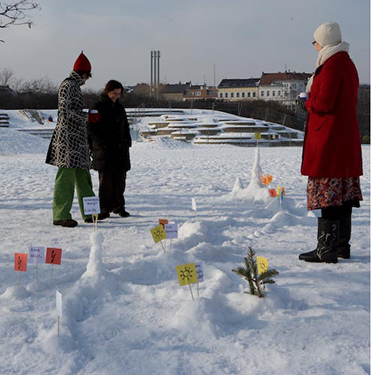
TARGET GROUP
Is participant experience relevant?It's okay if participants haven't seen the inside of a classroom in years. Physical trust needed
Mental trust needed
MATERIALSMaterial Description-A wooden board of about 1m length and at least 20cm width (We use wooden shelves which you can get cheaply in DIY shops.)
REQUIREMENTSDuration60 minutes – 10 minutes Experience level of the facilitatorroutine as participant OR professional facilitator Number of facilitators1 CHARACTER OF THE METHODLevel of activationcalmingHidden curriculumThere's no such thing as a sudden idea coming out of the blue. Woo-Woo Level – How touchy-feely is this method?From 1.Rationalist-Materialist “No feelings here, folks.” to 5.Esoteric-Shamanic Bleeding Heart: Innovation Phases:• 3 Fostering New Perspectives & Ways of Thinking Method Category:• Awareness raising |
SHORT DESCRIPTIONThis is a multisensual facilitation method that helps you understand complex patterns in a process flow. It helps you understand the history of a situation and develop from an understanding of the past an organically developing future scenario. BACKGROUNDBACKGROUND AND PURPOSEA team works together with clay and shows how the situation/team/company has developed by forming evolution lines showing ups and downs, aspects leading together and aspects that separate during the process of development up until now. The moments where something important has happened are labelled with little signs. The purpose of this method is to come to a deep (common) understanding of important milestones that led to the current situation. The assumption behind this approach is that you can influence future developments more smoothly from a point of understanding the past and present and from a point of view of processes and development flows instead of looking at a collection of single events. The common forming of the evolution lines also offers the opportunity to talk about different perceptions of the same situation. From that point of common understanding it is easier to agree on how to deal with that situation in future. ORIGINAL SOURCEThis method presented here is slightly changed by Visionautics, the original was developed by Stephan Otto, Evoco GmbH. STEP-BY-STEP GUIDEPREPARATION (excluding materials)Get clarity on how many teams/individual projects you will host. Prepare the material accordingly. Make sure things are prepared and set up nicely. This strengthens the participants' confidence in the process you are leading. Get clarity about your own intention with this exercise: What do you want the group to take away/learn/experience? What will be the most important thing to keep an eye on in order to achieve this? 1 IntroductionIntroduce the basic idea and purpose of the exercise to the group. 2 Clarifying the goalMake sure each person/team knows what topic they want to work on. Mostly it is clear already by the purpose the group gathered, but if it is not clear yet, give the participants space to clarify this (either individual reflection time or, if it is the work in a team, host a group discussion/brainstorming about the topic.) The central question in this phase is "What is it you want to develop further?" It can be an issue in society, a company, a team, a project, an aspect of a project, or an aspect of one's own life. 3 Getting startedEncourage your participants to form the clay and do storytelling about important milestones. Fresh clay is a great material to easily reshape, so make them shape their evolution line while they talk to each other. Tell them to use two thirds of the board's length to show the history of the issue/project. Be sure they include the ups and downs with different kinds of shapes becoming broader or thinner. When they're done with that, use the last third of the space to draft the future development. Here is a list of questions that help get things started. Give each group a printout of these questions. Tell them to mark special moments by sticking the sings into the clay at the specific places. They can either use the existing symbols or create their own symbols. They can also write special dates or milestones on the signs. 4 Developing phase in small teams / individual work(1-1,5 hours) 5 Outside perceptions & reflections(15 minutes per project) Questions that could help get this dialogue going could be: After hearing some associations and assumptions from the audience, the authors can say what the evolution line is about, what they found out during their process and from their dialogues along the formation of the evolution line, etc. Host a dialogue around new insights about this project and about the direction in which it would/could naturally develop. Take photos with the evolution line together with its team and place the evolution lines somewhere where they can be seen and appreciated for a while. HARVESTIn case you have done the harvesting in paired teams, come together in the plenum and give the opportunity to share the most important experiences and insights they gathered. Make it short. FURTHER INFORMATIONEXAMPLES1. A company, organization or team that wants to develop further their organization as a whole or a specific project. Sometimes people joined the organization/project team later. Here the evolution lines are very helpful for the elders to do some storytelling about what has happened at the very beginning. It also offers the possibility to appreciate what has been achieved so far and to see where problems started. Trainers for this method can be hired here:Visionautik Akademie, Evoco GmbH www.visionautik.de; www.evoco.de |